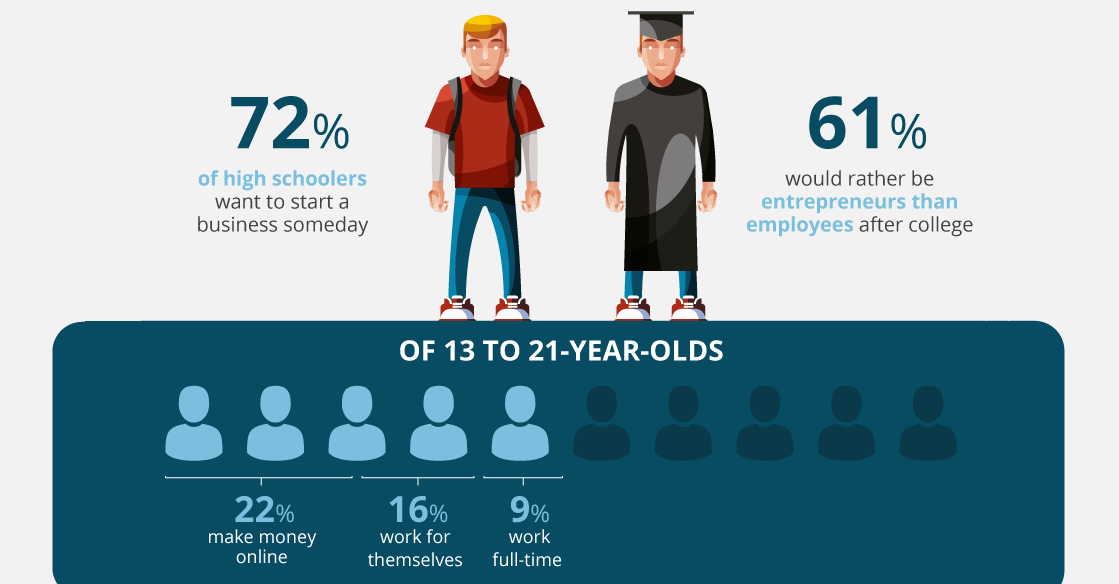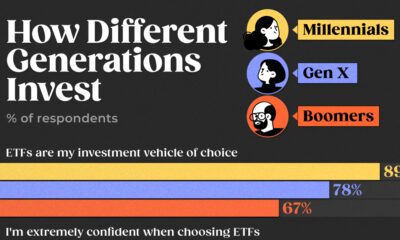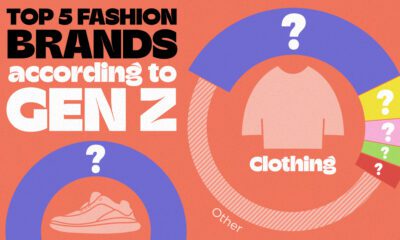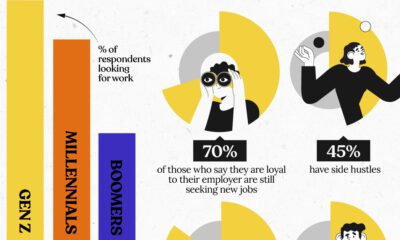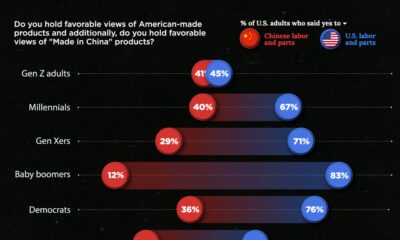Misc
The Major Pitfalls Faced by Young Entrepreneurs
Launching an ambitious new venture is challenging even at the very best of times.
But for young entrepreneurs, especially those in Gen Z (born after the year 2000), running a business can have even more complications that make it difficult to get basic tasks done.
Whether it’s credit card age limitations or simply not being taken seriously by employees or vendors, young entrepreneurs must find ways to overcome these business challenges.
Identifying the Pitfalls
Today’s infographic comes to us from Insurance Quotes, and it identifies the pitfalls encountered by young entrepreneurs as well as some of youth’s most important advantages.

Millennials, in comparison to the generation before them, have been less entrepreneurial as a whole. In fact, only 24% of 20-34 year olds today are new entrepreneurs, compared to a 34% rate from two decades ago.
Gen Z, however, is looking to take the reins – and now, 72% of high schoolers say they want to start a business someday.
Pitfalls for Young Entrepreneurs
Despite this increased interest in entrepreneurship, Gen Z faces significant pitfalls that must be overcome:
Age Limits
Many small businesses use credit cards or bank loans for day-to-day purposes, whether they are for picking up small expenses, growth capital, or as cash flow buffers.
However, in the United States, you must be 21 years old to get a credit card without a cosigner or proof of regular income. For bank loans, that age requirement drops to 18, but even then a cosigner or good credit is usually required.
In the same vein, age restrictions can also make it hard for young people to network, since many conferences or events take place in licensed establishments like bars or casinos.
Age Discrimination
Vendors, colleagues, and employees may not take young entrepreneurs seriously. Sometimes stereotypes of young people being a certain way may persist, as well.
Passing Class
Young entrepreneurs must divide time between business and school, creating competing priorities.
Rookie Mistakes
Inexperience can also be an early enemy for young entrepreneurs – hiring friends (instead of qualified people), micromanaging, being overprotective of new ideas, or mixing business and personal finances can be just some mistakes made from a lack of experience.
Advantages of Youth
Despite the list of potential pitfalls, it’s also clear that youth can provide big benefits to an up-and-coming business owner.
Firstly, the barriers to entry of business today are lower than ever before. It’s now possible to sell almost anything online for next to nothing, and Gen Z is inherently knowledgeable when it comes to exploiting any new technologies.
Next, without families to provide for or mortgages to pay, young people also typically have fewer responsibilities. This sets them up to take on risks that might steer away more seasoned businesspeople.
Lastly, a lack of experience can also be a massive advantage if used correctly. Young people have no preconceptions of “how things should be”, and can use that to pull off new ideas that others simply couldn’t imagine. This naiveté is arguably a big part of how today’s modern giants like Airbnb and Facebook came to be.
Misc
How Hard Is It to Get Into an Ivy League School?
We detail the admission rates and average annual cost for Ivy League schools, as well as the median SAT scores required to be accepted.

How Hard Is It to Get Into an Ivy League School?
This was originally posted on our Voronoi app. Download the app for free on iOS or Android and discover incredible data-driven charts from a variety of trusted sources.
Ivy League institutions are renowned worldwide for their academic excellence and long-standing traditions. But how hard is it to get into one of the top universities in the U.S.?
In this graphic, we detail the admission rates and average annual cost for Ivy League schools, as well as the median SAT scores required to be accepted. The data comes from the National Center for Education Statistics and was compiled by 24/7 Wall St.
Note that “average annual cost” represents the net price a student pays after subtracting the average value of grants and/or scholarships received.
Harvard is the Most Selective
The SAT is a standardized test commonly used for college admissions in the United States. It’s taken by high school juniors and seniors to assess their readiness for college-level academic work.
When comparing SAT scores, Harvard and Dartmouth are among the most challenging universities to gain admission to. The median SAT scores for their students are 760 for reading and writing and 790 for math. Still, Harvard has half the admission rate (3.2%) compared to Dartmouth (6.4%).
| School | Admission rate (%) | SAT Score: Reading & Writing | SAT Score: Math | Avg Annual Cost* |
|---|---|---|---|---|
| Harvard University | 3.2 | 760 | 790 | $13,259 |
| Columbia University | 3.9 | 750 | 780 | $12,836 |
| Yale University | 4.6 | 760 | 780 | $16,341 |
| Brown University | 5.1 | 760 | 780 | $26,308 |
| Princeton University | 5.7 | 760 | 780 | $11,080 |
| Dartmouth College | 6.4 | 760 | 790 | $33,023 |
| University of Pennsylvania | 6.5 | 750 | 790 | $14,851 |
| Cornell University | 7.5 | 750 | 780 | $29,011 |
*Costs after receiving federal financial aid.
Additionally, Dartmouth has the highest average annual cost at $33,000. Princeton has the lowest at $11,100.
While student debt has surged in the United States in recent years, hitting $1.73 trillion in 2023, the worth of obtaining a degree from any of the schools listed surpasses mere academics. This is evidenced by the substantial incomes earned by former students.
Harvard grads, for example, have the highest average starting salary in the country, at $91,700.
-

 Real Estate2 weeks ago
Real Estate2 weeks agoVisualizing America’s Shortage of Affordable Homes
-

 Technology1 week ago
Technology1 week agoRanked: Semiconductor Companies by Industry Revenue Share
-

 Money1 week ago
Money1 week agoWhich States Have the Highest Minimum Wage in America?
-

 Real Estate1 week ago
Real Estate1 week agoRanked: The Most Valuable Housing Markets in America
-

 Business2 weeks ago
Business2 weeks agoCharted: Big Four Market Share by S&P 500 Audits
-

 AI2 weeks ago
AI2 weeks agoThe Stock Performance of U.S. Chipmakers So Far in 2024
-

 Misc2 weeks ago
Misc2 weeks agoAlmost Every EV Stock is Down After Q1 2024
-

 Money2 weeks ago
Money2 weeks agoWhere Does One U.S. Tax Dollar Go?

